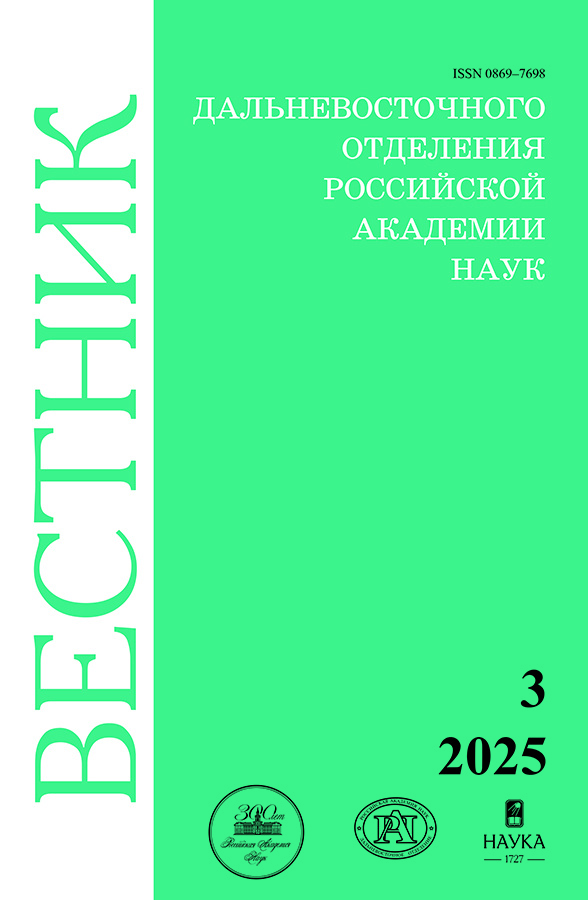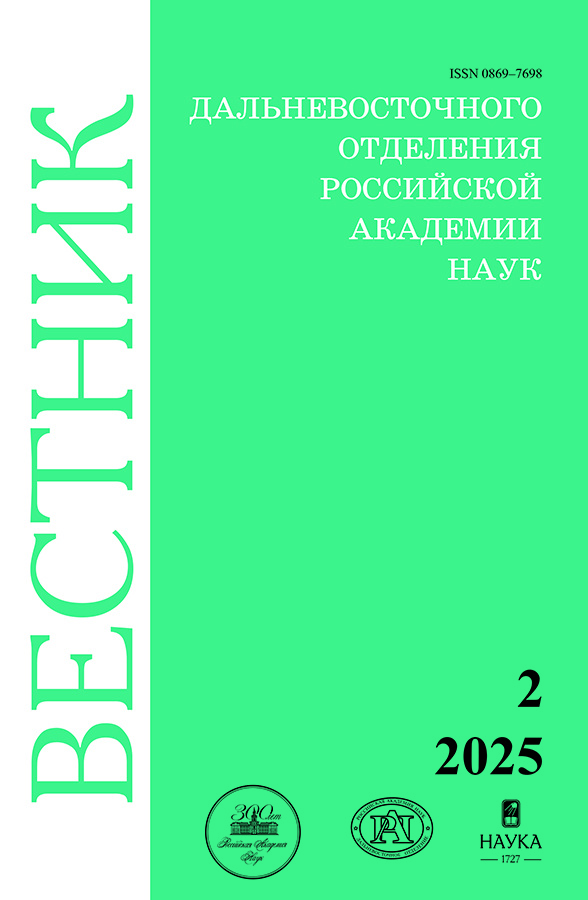Mathematical models combining ecological and genetic approaches in population biology
- Authors: Frisman E.Y.1, Zhdanova O.L.2, Neverova G.P.2
-
Affiliations:
- Institute for Comprehensive Analysis of Regional Problems, FEB RAS
- Institute of Automation and Control Processes, FEB RAS
- Issue: No 2 (2025)
- Pages: 102-123
- Section: Biological Sciences
- URL: https://permmedjournal.ru/0869-7698/article/view/687318
- DOI: https://doi.org/10.31857/S0869769825020084
- EDN: https://elibrary.ru/GEPNKM
- ID: 687318
Cite item
Full Text
Abstract
The review proposes a generalization of ecological and genetic approaches to problems traditionally considered within the framework of mathematical population biology. This approach is not the only possible one, but it seems to us original and promising, since сombining mathematical models of natural selection and population dynamics allows identifying possible mechanisms for the emergence of a complex temporal organization of genetic biodiversity very sensitive to external influences. When taking into account the age structure of populations in models, a multimodality appears, which not only makes it possible to explain the change in the dynamics mode, but also to take a fresh look at general biological ideas about existing patterns in population dynamics. Scenarios for the microevolution of the genetic composition of a population that arise with fluctuating numbers allow to explain and describe the pronounced genetic differentiation of individuals of different generations in populations with a seasonal pattern of reproduction; for example, the origin of differences in genetic structure among successive generations of Pacific pink salmon Oncorhynchus gorbuscha. Such models explain litter size polymorphism well in different (natural and artificial) populations of Arctic foxes Alopex lagopus; as well as the emergence and cessation of fluctuations in the numbers of several rodent species, which have recently been observed in many northern populations of Western Europe (for example, the disappearance of population cycles of voles in a number of populations in Finland and Sweden). The identified features of the dynamic behavior of such systems are important from the point of view of the revision and development of established theoretical concepts, since in such systems the principle of simple combination (superposition) of the results of two models is violated: density-independent natural selection of the best genotypes and density-dependent regulation of population growth; modes appear that were not observed separately in each of the models.
Full Text
About the authors
Efim Ya. Frisman
Institute for Comprehensive Analysis of Regional Problems, FEB RAS
Email: frisman@mail.ru
ORCID iD: 0000-0003-1629-2610
Corresponding Member of RAS, Professor, Scientific Director of the Institute
Russian Federation, BirobidzhanOksana L. Zhdanova
Institute of Automation and Control Processes, FEB RAS
Author for correspondence.
Email: axanka@iacp.dvo.ru
ORCID iD: 0000-0002-3090-986X
Doctor of Sciences in Physics and Mathematics, Leading Researcher
Russian Federation, VladivostokGalina P. Neverova
Institute of Automation and Control Processes, FEB RAS
Email: galina.nev@gmail.com
ORCID iD: 0000-0001-7567-7188
Doctor of Sciences in Physics and Mathematics, Senior Researcher
Russian Federation, VladivostokReferences
- Malthus T.R. An Essay on the Principle of Population. London: Yale University Press; 2018. 448 p.
- Darwin C. On the Origin of Species by Means of Natural Selection. London: John Murray; 1859. 440 р.
- Riznichenko G.Yu., Rubin A.B. Biofizicheskaya dinamika produktsionnykh protsessov. Moscow; Izhevsk: Institut komp’yuternykh issledovanii; 2004. 464 s. (In Russ.).
- Svirezhev Yu.M., Logofet D.O. Ustoychivost’ biologicheskikh soobshchestv. Moscow: Nauka; 1978. 352 s. (In Russ.).
- Bazykin A.D. Nelineynaya dinamika vzaimodeystvuyushchikh populyatsiy. Moscow; Izhevsk: In-t Kompyut. Issled.; 2003. 367 s. (In Russ.).
- Shapiro A.P., Luppov S.P. Rekurrentnye uravneniya v teorii populyatsionnoi biologii. Moscow: Nauka; 1983. 132 s. (In Russ.).
- May R.М. Biological populations with non-overlapping generations: stable points, stable cycles and chaos. Science. 1974;186:645–647.
- May R.M. Biological diversity: How many species are there? Nature. 1986;324(6097):514–515.
- Chitty D. Population processes in the vole and their relevance to general theory. Can. J. Zool. 1960;38:99–113.
- Pimentel D. Population regulation and genetic feedback. Science. 1968;159:1432–1437. https://doi.org/10.1126/science.159.3822.1432
- Birch L.C. Selection in Drosophila pseudoobscura in relation to crowding. Evolution. 1955;9(4):389–399.
- Charlesworth B. Selection in density-regulated populations. Ecology. 1971;52(3):469–474.
- Gottlieb L.D. Genetic stability in a peripheral isolate of Stephanomeria exigua ssp. coronaria that fluctuates in population size. Genetics. 1974;76(3):551–556.
- Gaines M.S., Leroy R., McClenaghan Jr., Rose R.K. Temporal patterns of allozymic variation in fluctuating populations of Microtus ochrogaster. Evolution. 1978;32(4):723–739.
- Frisman E.Ya. Izmenenie kharaktera dinamiki chislennosti populyatsii: mekhanizmy perekhoda k khaosu. Vestnik of the FEB RAS. 1995;(4):97–106. (In Russ.).
- Boonstra R., Boag P.T. A test of the Chitty hypothesis: inheritance of life-history traits in meadow voles Microtus pennsylvanicus. Evolution. 1987;41(5):929–947.
- Carroll S.P., Hendry A.P., Reznick D.N., Fox C.W. Evolution on ecological time-scales. Func. Ecol. 2007;21(3):387–393.
- Endler J.A. Natural selection on color patterns in Poecilia reticulata. Evolution. 1980;34(1):76–91.
- Reznick D.N., Bryga H. Life-history evolution in guppies (Poecilia reticulata): 1. Phenotypic and genetic changes in an introduction experiment. Evolution. 1987;41(6):1370–1385.
- Reznick D.A., Bryga H., Endler J.A. Experimentally induced life-history evolution in a natural population. Nature. 1990;346(6282):357–359.
- Stearns S.C. The Evolution of Life Histories. Oxford: Oxford University Press; 1992. 264 p.
- Williams D.W., Liebhold A. Detection of Delayed Density Dependence: Effects of Autocorrelation in an Exogenous Factor. Ecology. 1995;76(3):1005–1008.
- Sinervo B., Svensson E., Comendant T. Density cycles and an offspring quantity and quality game driven by natural selection. Nature. 2000;406:985–988.
- Yoshida T., Jones L.E., Ellner S.P., Fussmann G.F., Hairston Jr.N.G. Rapid evolution drives ecological dynamics in a predator–prey system. Nature. 2003;424:303–306.
- Pelletier F., Garant D., Hendry A.P. Eco-evolutionary dynamics // Phil. Trans. R. Soc. B. 2009;364:1483–1489.
- Mallet J. The struggle for existence. How the notion of carrying capacity, K, obscures the links between demography, Darwinian evolution and speciation. Evolutionary Ecology Research. 2012;14:627–665.
- Bertram J., Masel J. Density-dependent selection and the limits of relative fitness. Theor. Popul. Biol. 2019;129:81–92.
- Ellner S. Environmental fluctuations and the maintenance of genetic diversity in age or stage-structured populations. Bull. Math. Biol. 1996;58(1):103–127.
- Barton N., Briggs D., Eisen J., Goldstein D., Patel N. Evolution. N.Y.: Cold Spring Harbor Laboratory Press; 2007. 649 p.
- Yamamichi M., Ellner S.P. Antagonistic coevolution between quantitative and Mendelian traits. Proc. R. Soc. B Biol. Sci. 2016;283. 20152926.
- Yamamichi M., Hoso M. Roles of maternal effects in maintaining genetic variation: Maternal storage effect. Evolution. 2017;71(2):449–457.
- Ratner V.A. Dinamicheskaya teoriya biologicheskikh populyatsii. Moscow: Nauka; 1974. 456 s. (In Russ.).
- Axenovich T.I., Zorkoltseva I.V., Akberdin I.R., Beketov S.V., Kashtanov S.N., Zakharov I.A., Borodin P.M. Inheritance of litter size at birth in farmed arctic foxes (Alopex lagopus, Canidae, Carnivora). Heredity. 2007;98(2):99–105.
- Dazho R. Osnovy ehkologii. Moscow: Progress; 1975. 416 s. (In Russ.).
- Frisman E.Y., Zhdanova O.L. Evolutionary transition to complex population dynamic patterns in a two-age population. Russ. J. Genet. 2009;45(9):1124–1133.
- Neverova G.P., Zhdanova O.L., Frisman E.Y. The emergence of complex dynamics during the evolution of a structured limited population. Russ. J. Genet. 2020.56(7):747–757.
- Zhivotovskii L.A., Glubokovskii M.K., Viktorovskii R.M., Bronevskii A.M., Afanas’ev K.I., Efremov V.V. et al. Geneticheskaya differentsiatsiya gorbushi. Genetika. 1989;25(7):1261–1274. (In Russ.).
- Pustovoit S.P. Tridtsat’ let gipoteze flyuktuiruyushchikh stad gorbushi Oncorhynchus gorbuscha (Walbaum). Izvestiya TINRO. 2017;188:162–172. (In Russ.).
- Sato S., Urawa S. Genetic variation of Japanese pink salmon populations inferred from nucleotide sequence analysis of the mitochondrial DNA control region. Environmental Biology of Fishes. 2017;100(10):1355–1372. (In Russ.).
- Efremov V.V. Allozimnaya izmenchivost’ gorbushi (Oncorhynchus gorbuscha) Sakhalina. Voprosy Ikhtiologii. 2002;42(3):409–417. (In Russ.).
- Neverova G.P., Frisman E.YA. Rezhimy dinamiki populyatsii s neperekryvayushchimisya pokoleniyami s uchetom geneticheskoi i stadiinoi struktur. Computer Research and Modeling. 2020;12(5):1165–1190. (In Russ.).
- Hersteinsson P., Macdonald D.W. Diet of Arctic foxes (Alopex lagopus) in Iceland. J. Zool. 1996;240:457–474.
- Angerbjörn A., Tannerfeldt M., Erlinge S. Predator-prey relationships: Arctic foxes and lemmings. J. Anim. Ecol. 1999;68:34–49.
- Elmhagen B., Tannerfeldt M., Verucci P., Angerbjörn A. The arctic fox (Alopex lagopus) – an opportunistic specialist. J. Zool. 2000;251:139–149.
- Volodin I.A., Kalashnikova M.V., Klinkova E.S. et al. Structure of arctic fox (Alopex lagopus beringensis) colonies in the northern extremity of Bering Island. Biology Bulletin. 2013;40(7):614–625.
- Zhdanova O.L., Frisman E.Ya. Mathematical modeling of selection by sex-limited trait: to the question of maintenance of litter size polymorphism in natural populations of arctic foxes. Russ. J. Genet. 2021;57(2):227–237.
- Turelli M., Schemske D.W., Bierzychudek P. Stable two-allele polymorphisms maintained by fluctuating fitnesses and seed banks: protecting the blues in Linanthus parryae. Evolution. 2001;55:1283–1298.
- MacArthur R.H., Wilson E.O. The Theory of Island Biogeography. Princeton, N.J.: Princeton University Press; 1967.
- Zhdanova O.L., Frisman E.Ya. Genetic polymorphism under cyclical selection in long-lived species: the complex effect of age structure and maternal selection. J. Theor. Biol. 2021;512. 110564.
- Zhdanova O.L., Neverova G.P., Frisman E.Y. Predator evolution in a model of interacting species: to the question about maintaining polymorphism by litter size in natural populations of arctic fox. Russ. J. Genet. 2022. 58(1):94–108.
- Kausrud K.L., Mysterud A., Steen H. et al. Linking climate change to lemming cycles. Nature. 2008;456:93–97.
- Henttonen H., Wallgren H. Small rodent dynamics and communities in the birch forest zone of northern Fennoscandia. In: F.E. Wielgolaski (Ed.). Nordic Mountain Birch Ecosystems. New York: Parthenon; 2001. P. 262–278.
Supplementary files











